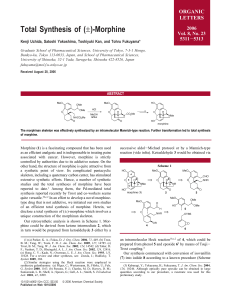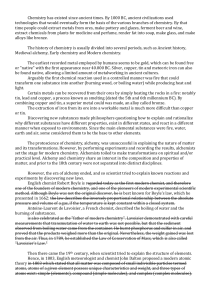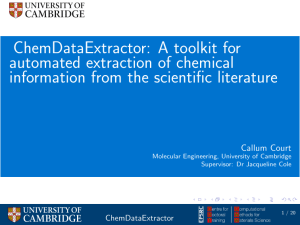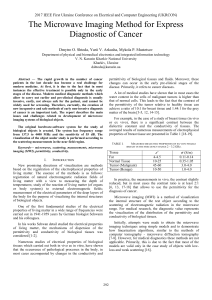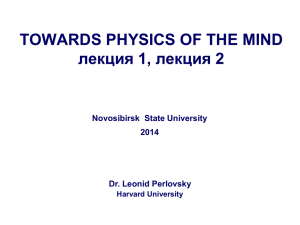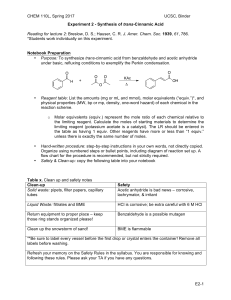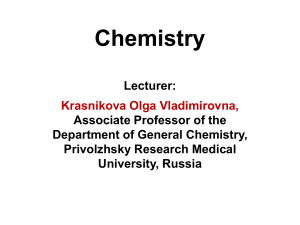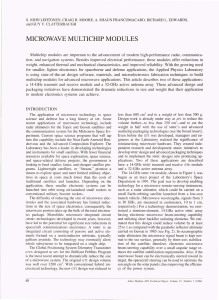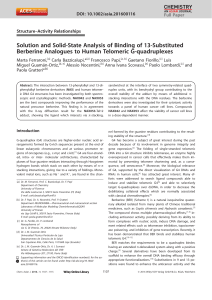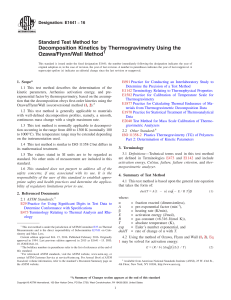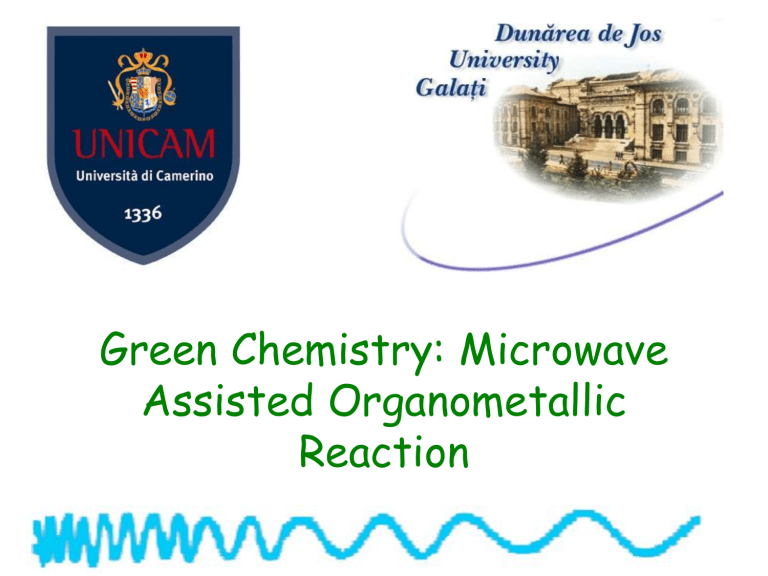
Green Chemistry: Microwave Assisted Organometallic Reaction Green Chemistry To promote innovative chemical technologies that reduce or eliminate the use or generation of hazardous substances in the design, manufacture, and use of chemical products. What does the Chemical Industry do for us? Green chemistry is about • • • • • • Waste Minimisation at Source Use of Catalysts in place of Reagents Using Non-Toxic Reagents Use of Renewable Resources Improved Atom Efficiency Use of Solvent Free or Recyclable Environmentally Benign Solvent systems Green Chemistry = Responsibility Why is there no ‘Green Geology’ or ‘Green Astronomy’? Because chemistry is the science that introduces new substances into the world and we have a responsibility for their impact in the world.” - Ronald Breslow Green Chemistry is also called… A new approach to designing chemicals and chemical transformations that are beneficial for human health and the environment An innovative way to design molecules and chemical transformations for sustainability Meeting the needs of the current generation without compromising the ability of future generations to meet their own needs Benign by design Pollution prevention at the molecular level What is Green Chemistry? • Green chemistry is the study of how to design chemical products and processes in ways that are sustainable and not harmful for humans and the environment. • Three components: catalysis, solvents, non-toxic • 12 principles of green chemistry Green Chemistry Is About... Waste Materials Hazard Risk Energy Cost Why do we need Green Chemistry ? • Chemistry is a very prominent part of our daily lives. • Chemical developments also bring new environmental problems and harmful unexpected side effects, which result in the need for ‘greener’ chemical products. • A famous example is the pesticide DDT. The 12 Principles of Green Chemistry (1-6) 1. Prevention It is better to prevent waste than to treat or clean up waste after it has been created. 2. Atom Economy Synthetic methods should be designed to maximise the incorporation of all materials used in the process into the final product. 3. Less Hazardous Chemical Synthesis Wherever practicable, synthetic methods should be designed to use and generate substances that possess little or no toxicity to people or the environment. 4. Designing Safer Chemicals Chemical products should be designed to effect their desired function while minimising their toxicity. 5. Safer Solvents and Auxiliaries The use of auxiliary substances (e.g., solvents or separation agents) should be made unnecessary whenever possible and innocuous when used. 6. Design for Energy Efficiency Energy requirements of chemical processes should be recognised for their environmental and economic impacts and should be minimised. If possible, synthetic methods should be conducted at ambient temperature and pressure. The 12 Principles of Green Chemistry (7-12) 7 Use of Renewable Feedstocks A raw material or feedstock should be renewable rather than depleting whenever technically and economically practicable. 8 Reduce Derivatives Unnecessary derivatization (use of blocking groups, protection/de-protection, and temporary modification of physical/chemical processes) should be minimised or avoided if possible, because such steps require additional reagents and can generate waste. 9 Catalysis Catalytic reagents (as selective as possible) are superior to stoichiometric reagents. 10 Design for Degradation Chemical products should be designed so that at the end of their function they break down into innocuous degradation products and do not persist in the environment. 11 Real-time Analysis for Pollution Prevention Analytical methodologies need to be further developed to allow for real-time, in-process monitoring and control prior to the formation of hazardous substances. 12 Inherently Safer Chemistry for Accident Prevention Substances and the form of a substance used in a chemical process should be chosen to minimise the potential for chemical accidents, including releases, explosions, and fires. What is “Green”? Sustainable Kinder and gentler to people and the planet Green Chemistry The cost of using hazardous materials: Conventional Heating vs Alternative Energy Source Conventional Heating Bunsen burner Oil bath Heating mantle Alternative Energy Sources Microwave Ultrasound Sunlight / UV Electonchemistry Clean Chemical Synthesis Using Alternative Reaction Methods Alternative Energy Sources Microwave Ultrasound Sunlight / UV AlternativeReactionMedia/Solvent-free Supercritical Fluids Ionic Liquids Water Polyethylene glycol (PEG) Solvent free Microwaves in Synthesis History or how it all began… • While fire is now rarely used in synthetic chemistry, it was not until Robert Bunsen invented the burner in 1855 that the energy from this heat source could be applied • There is some controversy about the origins of the microwave power cavity called the magnetron – the high-power generator of microwave power. The British were particularly forward-looking in deploying radar for air defense with a system called Chain Home which began operation in 1937. Originally operating at 22 MHz, frequencies increased to 55 MHz. 1921 was published by A.W. Hull the earliest description of the magnetron, a diode with a cylindrical anode 1940 It was developed practically by Randall and Booth at the University of Birmingham in England ; they verified their first microwave transmissions: 500 W at 3 GHz. A prototype was brought to the United States in September of that year to define an agreement whereby United States industrial capability would undertake the development of microwave radar. 1940 the Radiation Laboratory was established at the Massachusetts Institute of Technology to exploit microwave radar. More than 40 types of tube would be produced, particularly in the S-band (i.e. 300 MHz). The growth of microwave radar is linked with Raytheon Company and P.L. Spencer who found the key to mass production. History or how it all began… • 1946 Dr. Percy Spencer-the magnetron inventor; he has found a variety of technical applications in the chemical and related industries since the 1950s, in particular in the food-processing, drying, and polymer • surprisingly, microwave heating has only been implemented in organic synthesis since the mid1980s. • Today, a large body of work on microwave-assisted synthesis exists in the published and patent literature. • Many review articles, several books and information on the world-wide-web already provide extensive coverage of the subject. • 1969 “ Carrying out chemical reactions using microwave energy ” J.W. Vanderhoff – Dow Chemical Company US 3,432,413 • 1986 “The Use of Microwave Ovens for Rapid Organic Synthesis” Gedye, R. N. et alTetrahedron Lett. 1986, 27, 279 • 1986 “Application of Commercial Microwave Ovens to Organic Synthesis” Giguere, R. J. and Majetich, G. Tetrahedron Lett. 1986, 27, 4945 Energy Use in Conventional Chemical Processes Heating Stirring Piping Transporting Cooling Problem of Conventional Heating You heat what you don’t want to heat. Solvents for reactions, apparatus: heated up and cool it down. Double energy penalty without any apparent “benefit”. Energy Consumptions Three ways to get the reaction done, but different energy bills to pay Microwaves • MW reactors operate at 2.45 GHz. • Electric field oscillates at 4.9 x 109 times/sec – 10oC/sec heating rate. Electromagnetic Spectrum Neas, E.; Collins, M. Introduction to Microwave Sample Preparation: Theory and Practice, 1988, p. 8. Schematic of a Microwave E= electric field H= magnetic field l= wavelength (12.2 cm for 2450 MHz) c= speed of light (300,000 km/s) Microwaves Application in Heating Food 1946: Original patent (P. L. Spencer) 1947: First commercial oven 1955: Home models 1967: Desktop model 1975: U.S. sales exceed gas ranges 1976: 60% of U.S. households have microwave ovens Spectrum Electromagnetic • • • • • Electric field component Responsible for dielectric heating Dipolar polarization Conduction Magnetic field component Microwaves – Dipolar Rotation • Polar molecules have intermolecular forces which give any motion of the molecule some inertia. • Under a very high frequency electric field, the polar molecule will attempt to follow the field, but intermolecular inertia stops any significant motion before the field has reversed, and no net motion results. • If the frequency of field oscillation is very low, then the molecules will be polarized uniformly, and no random motion results. • In the intermediate case, the frequency of the field will be such that the molecules will be almost, but not quite, able to keep in phase with the field polarity. • In this case, the random motion resulting as molecules jostle to attempt in vain to follow the field provides strong agitation and intense heating of the sample. • At 2.45 GHz the field oscillates 4.9 x 109 times/s which can lead to heating rates of 10 °C per second when powerful waves are used MW Heating Mechanism Noconstraint Continuous electric field Two mechanisms: Dipolar rotation / polarization Ionic Conduction mechanism Alternating electric field Withhigh frequency Microwave Dielectric Heating Mechanisms Conduction Mechanism Dipolar Polarization Mechanism Dipolar molecules try to align to an oscillating field by rotation Ions in solution will move by the applied electric field Mingos, D. M. P. et al., Chem. Soc. Rev. 1991, 20, 1 and 1998, 27, 213 Microwave vs Oil-bath Heating J.-S. Schanche, Mol. Diversity 2003, 7, 293. www.personalchemistry.-com; www.biotage.com. Conventional Heating by Conduction Conductive heat Heating by convection currents Slow and energy inefficient process temperature on the outside surface is in excess of the boiling point of liquid Direct Heating by Microwave Irradiation •Solvent/reagent absorbs MW energy • Vessel wall transparent to MW •Direct in-core heating •Instant on-off Inverted temperature gradients! Molecular Speeds Molecular Speeds Microwave Ovens Cooking Food! Cooking Chemistry ??? Household MW ovens The Use of Microwave Ovens for Rapid Organic Synthesis R. Gedye et al., Tetrahedron Lett. 1986, 27, 279. Publications on MW-Assisted Organic Synthesis 7 Synthetic Journals: J.Org.Chem.,Org.Lett.,Tetrahedron Lett.,Tetrahedron, Synth.Commun., Synlett, Synthesis All Journals (Full Text): Dedicated instruments only (Anton Paar, Biotage, CEM, Milestone, Prolabo) Industrial /Chemical / Applications of Microwave Heating Food Processing + Defrosting + Drying / roasting / baking + Pasteurization Drying Industry + Wood, fibers, textiles + Pharmaceuticals + Brick / concrete walls Polymer Chemistry + Rubber curing, vulcanization + Polymerization Ceramics/Materials + Alumina sintering + Welding, smelting, gluing Plasma + Semiconductors Waste Remediation + Sewage treatment Analytical Chemistry + Digestion + Extraction + Ashing Biochemistry / Pathology + Protein hydrolysis + PCR, proteomics + Tissue fixation + Histoprocessing Medical + Diathermy, tumor detection + Blood warming + Sterilization (Anthrax) + Drying of catheters Books on MicrowaveAssisted Synthesis (ACS Professional Reference Book) H. M. Kingston, S. J. Haswell (eds.) Fundamentals of Microwave Application Alternative Laboratory Microwave Instruments Chemistry Applications Biochemistry Applications Laboratory Microwave Safety Microwaves in Organic and Medicinal Chemistry Kappe, C. O. and Stadler, A. Wiley-VCH, Weinheim, 2005, ISBN: 3-527-31210-2 410 pages, ca 1000 references, Hayes, B. L., CEM Publishing, Matthews, NC, 2002 Books on MicrowaveAssisted Synthesis Lidstöm, P.; Tierney, J. P. (Eds.), Blackwell Scientific, 2005 Loupy Andre (Ed.) Wiley-VCH, Weinheim, 2003, ISBN: 3-527-30514-9 523 pages, 2000 refs. Book (2 volumes) WileyVCHA. Loupy edit Second Edition (2006) 22 Chapters Books on Microwave-Assisted Synthesis Astra Zeneca Research Foundation Kavitha Printers, Bangalore, India, 2002 [email protected] Practical Microwave Synthesis for Organic Chemists Strategies, Instruments, and Protocols Edition - 2009, X, 310 Pages, Hardcover, Monograph Microwave Ovens Monomodal instrument Piccoli volumi processabili - Onde Stazionarie (Hot Spots) - Difficoltà nello Scale-up + Alta densità d’energia Images adapted from: C.O. Kappe, A. Stadler: Microwaves in Organic and Medicinal Chemistry, Wiley, 2005 Multimodal instrument + Alta densità d’energia (maggior potenza disponibile) + Maggiori volumi processabili (cavità a MW più grande) + No Onde Stazionarie (No Hot-spots) + Semplice Scale-up - Volume minimo processabile Monomodal Vs. Multimodal Monomodal Vs. Multimodal Thermal Effects •More efficient energetic coupling of solvent with microwaves promotes higher rate of temperature increase • Inverted heat transfer, volumetric • “Hot spots” in monomode microwaves • Selective on properties of material (solvents, catalysts, reagents, intermediates, products, susceptors) Recent Applications of MicrowaveAssisted Synthesis-MAOS Hydrolysis of benzamide thermal: 1 h, 90 % yield (reflux) MW: 10 min, 99 % yield (sealed vessel) R. Gedye, F. Smith, K. Westaway, H. Ali, L. Baldisera, L. Laberge, J. Rousell, Tetrahedron Lett. 1986, 27, 279–282. R. J. Giguere, T. L. Bray, S. M. Duncan, G. Majetich, Tetrahedron Lett. 1986, 27, 4945–4958. The first reports on the use of microwave heating to accelerate organic chemical transformations (MAOS) were published by the groups of Richard Gedye (and Raymond J. Giguere/George Majetich in 1986. In those early days, experiments were typically carried out in sealed Teflon or glass vessels in a domestic household microwave oven without any temperature or pressure measurements. The results were often violent explosions due to the rapid uncontrolled heating of organic solvents under closed-vessel conditions. Solvent-free Reactions or Solid-Solid Reactions “No reaction proceeds without solvent” Aristotle Green chemistry enabled advancement Solventless syntheses Solvent-free Organic Synthesis Chemical Synthesis w i t h o u t t h e u s e o f solvents has developed intoapowerful methodology as it reduces the amount of toxic waste produced and therefore becomes less harmful to the environment Solvent-free Organic Synthesis Best solvent is no solvent! • Clean and efficient synthesis • Economic and environmental impact • Fast reaction kinetics Adolf von Baeyer Synthesis of Indigo Towards benign synthesis with remarkable Versatility G. W. V. Cave, C. L. Raston, J. L. Scott Chem.Commun. 2001, 2159 Solid-State General Oxidation with with Urea H2O2 Complex R. S. Varma and K. P. Naiker, Org. Letters, 1999, 1, 189. Solvent-free Oxidative Preparation of Heterocycles Kumar, Chandra Sekhar, Dhillon, Rao, and Varma,Green Chem., 2004, 6, 156-157. Solvent-free Synthesis of ß-Keto Keto Sulfones Ketones Kumar, Sundaree, Rao and Varma,Tetrahedron Letters, 2006, 47, 4197-4199. Solvent-free Reduction F. Toda et al. Angew. Chem. Int. Ed. Engl., 1989, 28, 320and Chem. Commun., 1989, 1245. Carbon-Carbon Bond Formation Toda, Tanada, Iwata, J. Org. Chem., 1989, 54, 3007. Solventless Photo Coupling and Photo Rearangements Y. Ito, S. Endo, J. Am. Chem. Soc. 1997, 119, 5974. Shin, Keating, Maribay, J. Am. Chem. Soc. 1996, 118, 7626. Solvent - Free Condensation Z. Gross, et al., Org. Letters, 1999, 1, 599. Solid-State Preparation of Dumb-bell-shaped C120 Wang, Komatsu, Murata, Shiro, Nature 1997, 387, 583 Advantages of Solid Mineral Supports (Alumina, Silica and Clay) Good dispersion of active (reagent) site can lead to significant improvement of reactivity–large surface area. The constraints of the (molecular dimensions) pores and the characteristics of the surface adsorption can lead to useful improvement in reaction selectivity. Solids are generally easier and safer to handle than liquids or gaseous reagents. Inexpensive, recyclable and environmentally benign nature. Solid-supported Solventless Reactions • Microwave irradiation of solventless reactions with inorganic mineral supports such as alumina, silica, or clays have resulted in faster reactions with higher yields with simplified separation. R. S. Varma, Tetrahedron, 2002, 58, 1235. R. S. Varma, Green Chem., 1999, 1, 43. Supported Reactions Using Microwaves E. Gutterrez, A. Loupy, G. Bram, E. Ruiz-Hitzky, Tetrahedron Lett. 1989, 30, 945. Microwave-Assisted Deacetylation on Alumina Varma et al.: J. Chem. Soc., Perkin Trans. 1, 999 (1993) Deprotection of Benzyl Esters via Microwave Thermolysis A practical alternative to traditional catalytic hydrogenation Varma et al.: Tetrahedron Lett., 34, 4603 (1993) Solid State Deoximation with Ammonium Persulfate-Silica gel Regeneration of Carbonyl Compounds Using Microwaves Varma, Meshram: Tetrahedron Lett., 38, 5427 (1997) Solid State Cleavage of Semicarbazones/Phenylhydrazones with Amm. Persulfate–Clay using Microwave and Ultrasonic Irradiation Varma, Meshram: Tetrahedron Lett., 38, 7973 (1997) Solid Supported Solvent-free Oxidation under MW Varma et al., Tetrahedron Lett., 1997, 38, 2043 and 7823 Solvent-free Reduction Using MW Chemoselective reduction of trans-cinnamaldehyde: olefinic moiety remains intact and the aldehyde functionality is reduced in a facile reaction. Varma et al., Tetrahedron Lett., 1997, 38, 4337 Hydrodechlorination under continuous MW Pillai, Sahle-Demessie, Varma: Green Chemistry, 6, 295 (2004) Synthesis of Heterocyclic Compounds Varma et al.: J. Chem. Soc. Perkin Trans 1, 4093 (1998) Varma, J. Heterocycl. Chem., 36, 1565 (1999) Synthesis of Heterocyclic Compounds Organometallic Reactions Rearrangements Rearrangements INDOLIZINES R2 8 R1 7 6 1 N 5 4 2 3 R3 Heterocyclic systems, 10- p electronics Structure of many naturals alkaloids : (-) slaframine, (-) dendroprimine, indalozine, coniceine Key intermediates in indolizidines, bisindolizines, ciclofans, ciclazines synthesisbiologic actives compounds Why interest for indolizinic products Strong fluorescent properties luminiscent products Potentially fluorescents marker Potentially laser“scintillaters” Strong inhibitors for lipid peroxydation (15-lipooxygenase inhibitors ) Biologic actives products Ligands for estrogen receptors Possible inhibitory activity for phospholipase A2 “Calcium-entry” blockers • Bioorg. & Med. Chem. Lett., 16, 59, 2006 •Tetrahedron, 61, 4643, 2005 • Bioorg. & Med. Chem., 10, 2905, 2002 • J. Org. Chem., 69, 2332, 2004 • Dyes and Pigments, 46, 23, 2000 •J. of Luminiscence, 82, 155, 1999 Indolizines by irradiation with microwaves, in MCR R2 O Br + R + R1 Al2O3 R2 Mw R1 N N R=Ph, p-Tolil, Stiril, COR AcO R1= H, COOMe R2= COOEt, COOMe U. Bora, A. Saikia, R. C. Boruah – Organic Lett., 5 (4), 435, 2003; O R1 Cl + R2 2% [Pd(PPh3)2Cl2 4% CuI 20 echiv. Et3N, THF, t.c., 2h EtOOC R1=Ph, 4-OMe-C6H4 R2= Ph Br N Br N O O EtOOC N OMe R2 COR 1 N OMe R2 COR 1 Asymmetric indolizines, by irradiation with microwaves, in MCR A. Rotaru, I. Druţă, T. Oeser, T. Muller – Helv. Chim. Acta, 88, 1798, 2005; Synthesis of new indolizines [3+2] dipolar cycloaddition of symmetrical or non-symmetrical 4,4’-bipyridiniummethyne-ylids with actives alkynes, symmetrical or non-symmetrical : - - R1 X N CH2 X C CH2 N O C R2 O TEA - 2 HX anhydrous solvents R1 C CH O N C N 2 R'O OC N CH C O C C R1 COO R' R2 CH N O CH C R2 O H C N N 2 H C C COOR' I C C COOR' N C O H C C R2 O H COOR' II R1 C C R2 O COOR' N H R1= COOR', C6H4Y R2=COOR', C6H4Y R'=CH3, C2H5 Y=H, NO 2, OCH3, CH3, Cl, Br X=Br, Cl C O R'OOC COOR' R1 R1 C (A) N COOR' N C O R'OOC C R2 O COOR' H (B) H •I. Druţă, R. Dinică, E. Bâcu, I. Humelnicu – Tetrahedron, 54, 10811, 1998 •R. Dinică, C. Pettinari – Heterocycl. Comm., 07(4), 381, 2001 •A. V. Rotaru, R. P. Dănac, I. Druţă – J. Heterocyclic Chem., 41, 893, 2004 •A. Rotaru, I. Druţă, T. Oeser, T. Muller – Helv. Chim. Acta, 88, 1798, 2005 Synthesis of new substituted pyridiniumindolizines Indolizinic cycloadducts using like dipolarophile 4-nitro-phenyl propiolate I I H3C N (9a-d) I I KF/NMP N H3C N R -HI H3C N N O R H O O (10a-d) HC C COO a: R= OCH3 b: R= C6H5 c: R= p-C6H4-OCH3 d: R= p-C6H4-NO2 N R NO2 NMP 95o C, 30 min I II I H3C N I O N H3C N O N R R O O O O NO2 NO2 -2[H] -2[H] 6' I 5' H3C N 5 3' 4 3 N 4' 7 1' 2' 6 8 9 1 11 O (A) 2 O 10 R I H3C N O N R O O O (B) NO2 (15a-d) NO2 Indolizine synthesis in solid phase, under microwaves R R2 R C R1 CH2 N X N a) (C2H5)3N in C6H6 sau N-metilpirolidona R1 C + 2 b) microunde, KF alumina C R2 N N X R2 CH2 C R R1 2R N N X microunde, KF alumina R C N R N C R + 2 R2 C C R1 R1 R2 R1 R2 Monoindolizine synthesis in solid phase, under microwaves CH3 CH3 a) KF/Al2O3 MW 10 min, 95oC I N + HC C COOC 2H 5 I N b)Et3N/NMP 50-60 oC, 6-9h O N N I c)KF/Al2O3 95oC, 10 min O OC2H5 O R R (9a-d) (12a-d) a: R= OCH3 b: R= C6H5 c: R= p-C6H4-OCH3 d: R= p-C6H4-NO2 Reaction conditions and the yelds for synthesized compounds (12a-d) Solution Solid phase Microwaves Comp. Time (min) T (°C) h (%) Time (min) T (°C) h (%) Time (min) T (°C) h (%) 12a 480 50 63 10 95 57 10 95 84 12b 480 50 61 10 95 50 10 95 77 12c 480 55 71 10 95 52 10 95 85 12d 480 60 53 10 95 47 10 95 71 • B. Furdui, R. Dinică, I. Druţă, M. Demeunynck –Synthesis, 16, 2640, 2006 Benefits of MW-Assisted Reactions • Higher temperatures (superheating / sealed vessels) • Faster reactions, higher yields, any solvent (bp) • Absolute control over reaction parameters • Selective heating/activation of catalysts, specific effects • Energy efficient, rapid energy transfer • Can do things that you can not do conventionally • Automation / parallel synthesis – combichem MW-Assisted Solvent-free Three Component Coupling: Formation of Propargylamines Ju, Li and Varma, QSAR & Combinatorial Science, 2004, 23, 891 Solvent-free Synthesis of Ionic Liquids Varma, Namboodiri, Chem. Commun., 2001, 643. Varma, Namboodiri, Pure Appl. Chem., 2001, 73, 1307. Namboodiri, Varma, Chem. Commun., 2002, 342. MW Synthesis of Tetrahalideindate(III)-based IL Kim and Varma. J. Org. Chem., 2005, 70, 7882. PEG, a Biodegradable “Solvent” • • • • • • • • • • • PEG has been applied in bioseparations. PEG is on the FDA’s GRAS list, (compounds Generally Recognized as Safe) and has been approved by the FDA for Internal consumption. PEG is weakly, immunogenic, a factor which has enabled the development of PEG–protein conjugates as drugs. Aqueous solutions of PEG are biocompatible and are utilized in tissue culture media and for organ preservation. PEGs are nonvolatile PEG has low flammability PEG is biodegradable J. Chen, S. K. Spear, J. G. Huddleston, R.D. Rogers, Green Chem.. 2005, 7, 64. Suzuki Cross-Coupling Reaction in PEG Accelerated by Microwaves V. Namboodiri, R. S. Varma: Green Chemistry, 2001, 3, 146. Advantages of Present Approach PEG offers a convenient recyclable reaction medium Good substitute for volatile organic solvents The microwave heating offers a rapid and clean alternative at high solid concentration and reduces the reaction times from hours to minutes The recyclability of the catalyst makes the reaction economically and potentially viable for commercial applications Water as a “cleaner” solvent • • • • • • • Water is not a popular choice of solvent, reactivity in heterogeneous aqueous media is not very well understood But It brings biochemistry and organic chemistry closer together in the beneficial use of water as the reaction medium, it is abundant, inexpensive and clean. Cu (I) Catalyzed Click Chemistry P. Appukkuttan, W. Dehaen, V. V. Fokin, E. Van der Eycken. Org. Lett. 2004, 6, 4223. N-alkylation of Amines using Alkyl Halides Ju, Y.; Varma, R. S., Green Chem. 2004, 6, 219-221. Aqueous N-alkylation of Amines using Microwave Irradiation Ju, Y.; Varma, R. S., Green Chem. 2004, 6, 219-221. Why Amines and Heterocycles ? MW Synthesis of N-Aryl Azacycloalkanes Ju; Varma, Tetrahedron. Lett., 2005, 46, 6011. Ju; Varma, J. Org. Chem., 2006, 71, 135. Choice of Reaction Media MW -assisted one-pot synthesis of triazoles Designing a “greener” synthesis • • • • • Plan! Maximize convergence Consider using renewable starting materials Avoid super toxic reagents Strive for high atom economy – Use catalytic over stoichiometric – Avoid auxiliaries and protecting groups • Consider greener solvents • Minimize number of purifications Take Aways • “Green chemistry” is not so far away from what we do everyday – High yields – Minimal number of steps – Minimize number of purifications • Green principles to keep in mind – Strive for atom economy – Consider the toxicity and necessity of reagents and solvents Green Chemistry Opportunities Conferences – Annual ACS Green Chemistry and Engineering Conference – Annual Gordon Conferenece, Green Chemistry • Funding – PRF green chemistry grants – NSF green chemistry grants – EPA funding Conclusion Not a solution to all environmental problems But Green chemistry the most fundamental approach to preventing pollution. • Today, a large body of work on microwaveassisted synthesis exists in the published and patent literature. • Many review articles, several books and information on the world-wide-web already provide extensive coverage of the subject. Lead References • Lidström, P.; Tierney, J.P.; Wathey, B.; Westman, J. Tetrahedron 2001, 57, 9225 • Hayes, Brittany, L. Microwave Synthesis. Chemistry at the Speed of Light. North Carolina: CEM Publishing, 2002. • Tierney, J.P., and P. Lidström, ed. Microwave Assisted Organic Synthesis. Oxford: Blackwell Publishing Ltd, 2005. • de la Hoz, A.; Diaz-Ortiz, A.; Moreno, A. Chem. Soc. Rev. 2005, 34, 164. Lead References reviews A. Loupy, A. Petit, J. Hamelin, F. Texier- Boullet, P. Jacquault, D. Math_, Synthesis1998, 1213–1234; R. S. Varma, Green Chem. 1999, 43–55; M. Kidawi, Pure Appl. Chem. 2001, 73, 147–151; R. S. Varma, Pure Appl. Chem. 2001, 73, 193–198; R. S. Varma, Tetrahedron 2002, 58, 1235–1255; R. S. Varma, Advances in Green Chemistry: Chemical Syntheses Using Microwave Irradiation, Kavitha Printers, Bangalore, 2002. A. K. Bose, B. K. Banik, N. Lavlinskaia, M. Jayaraman, M. S. Manhas, Chemtech 1997, 27, 18–24; A. K. Bose, M. S. Manhas, S. N. Ganguly, A. H. Sharma, B. K. Banik, Synthesis 2002, 1578–1591. C. R. Strauss, R. W. Trainor, Aust. J. Chem. 1995, 48, 1665–1692; C. R. Strauss, Aust. J. Chem. 1999, 52, 83– 96; C. R. Strauss, References books Microwaves in Combinatorial and High-Throughput Synthesis (Ed.: C. O. Kappe), Kluwer, Dordrecht, 2003 (a special issue of Mol. Diversity 2003, 7, pp 95–307); Stadler, C. O. Kappe, Microwave-Assisted Organic Synthesis (Eds.: P. Lidstr_m, J. P. Tierney), Blackwell Publishing, Oxford, 2005 (Chapter 7). A. Loupy (Ed.), Microwaves in Organic Synthesis, Wiley-VCH, Weinheim, 2002. B. L. Hayes, Microwave Synthesis: Chemistry at the Speed of Light, CEM Publishing, Matthews, NC, 2002. P. Lidstrom, J. P. Tierney (Eds.), Microwave- Assisted Organic Synthesis, Blackwell Publishing, Oxford, 2005. For online resources on microwave-assisted organic synthesis (MAOS), see: www.maos.net. THANK YOU FOR YOUR ATTENTION! 118
